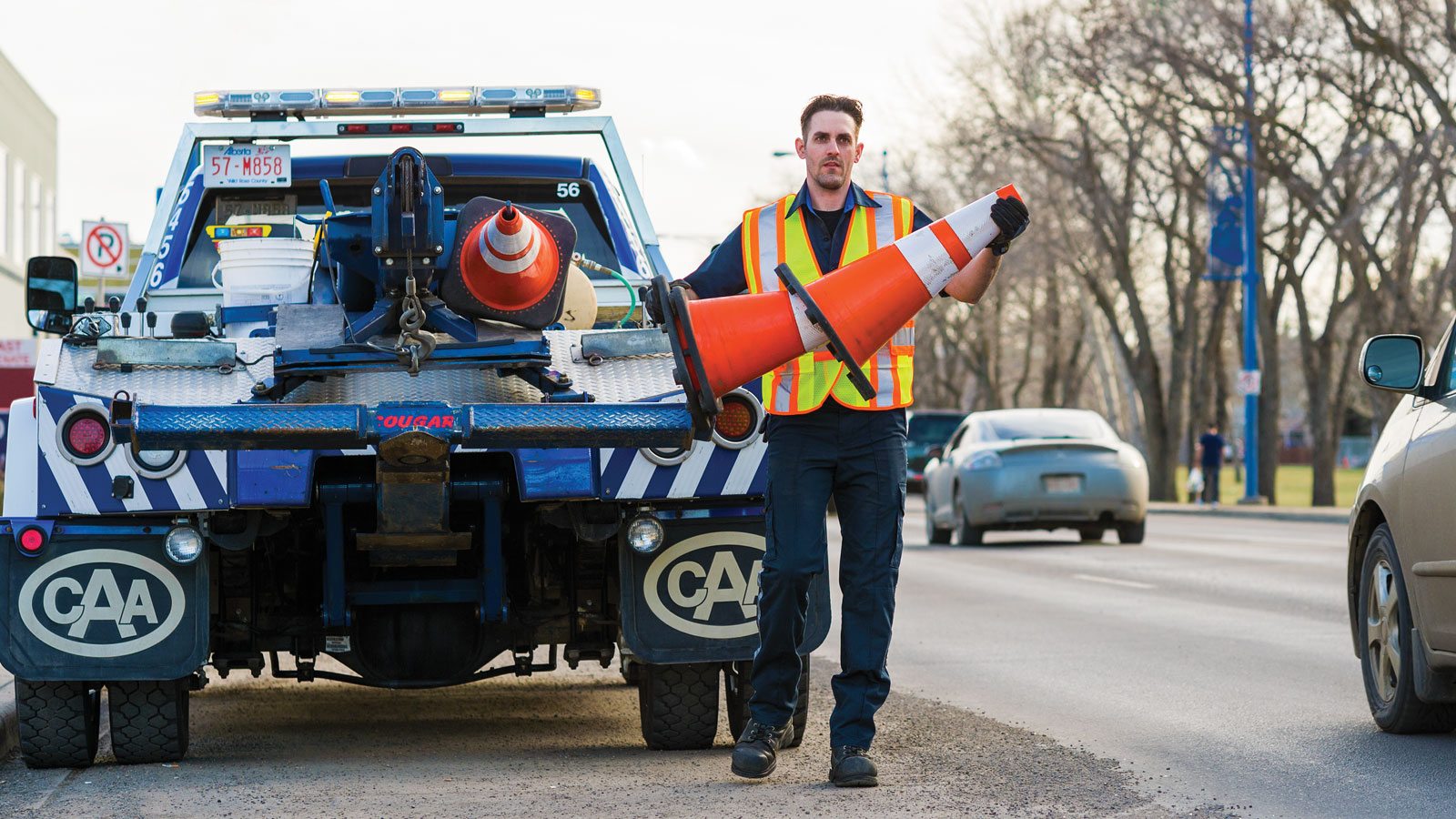Update: Starting September 1, 2023, when you see tow trucks, emergency vehicles, maintenance vehicles or snowplows stopped with their lights flashing, you must slow to 60 km/h (or less if the speed limit is lower) in the adjacent lane. You should also move over a lane, if it’s safe to do so.
A young father of two was changing a tire on the shoulder of a quiet Edmonton street when he saw vehicle headlights coming straight for him. He leapt to safety—just in time to see a Jeep plough through three of the safety pylons laid out 15 metres ahead of the breakdown.
That father was Darren Klassen, an AMA tow truck operator, who was helping a member when the terrifying incident occurred. “The driver realized what had happened after she hit the second pylon and started to swerve away from me,” Klassen recalls. “I noticed there was a cell phone in her hand at the time.”
Klassen took every precaution that day: He was wearing his brightly coloured safety vest, pylons were carefully arranged to mark the scene, and his tow truck’s amber lights were flashing. Yet a single driver’s inattention put his livelihood—and his life—in jeopardy.
Other incidents in Alberta are also poignant reminders of the dangers tow truck operators face every day. A Calgary tow operator was hospitalized after being hit by a car on Deerfoot Trail, a collision that saw him bounce off the windshield roughly nine metres in the air.
In a separate incident on Calgary’s Glenmore Trail, a BMW, travelling at an estimated speed of 100 kilometres per hour, hit a flatbed tow truck with such force that the car it was towing went airborne across two lanes of traffic. And in Edmonton, an inattentive driver came within half a metre of hitting a tow operator after swerving to avoid another car that had rightfully slowed down.
Klassen and his coworkers have experienced too many near misses to count. “I don’t want my wife and kids to be scared for me every time I head off to work,” Klassen says.

AMA’s Roadside Assistance team receives rigorous training to ensure that they and the members they’re helping stay safe at the roadside. Tow operators are provided with ongoing high-risk training that covers proper pylon placement, safe ways to walk around a scene, and the use of a second service truck to shelter breakdown scenes in dangerous locations.
But everyone needs to do their part. “The roadways are shared spaces. Everyone using them has a responsibility to follow the rules of the road and drive according to appropriate conditions, particularly in hazardous situations,” says Ryan Lemont, manager of AMA Driver Education. “We do our best to create a safe work environment on the side of the road, and we want everyone to go home safely at the end of the day. It’s not just emergency personnel and AMA operators on scene, it could be someone’s grandpa, mother or child waiting for a tow.”
Part of the problem is that motorists aren’t aware that the passing rules that apply to emergency vehicles (police, fire and ambulance) also apply to tow trucks. “It’s been the law since 2005—nearly 20 years—yet people still don’t know what to do when they see tow trucks at the side of the road,” Lemont says. “Treat a tow truck with its flashing lights the same way you would treat an emergency vehicle at the side of the road. Slow down and safely create as much distance as possible between your vehicle and those around you.”
Stay Alert!
Discover five easy ways you can help keep Alberta’s roadsides safe.
Speed fines double for drivers who don’t slow down to at least 60 kilometres per hour or the posted limit (whichever is lower) when passing a parked tow truck with flashing lights. There are the demerit points as well, which vary depending on how fast the offending vehicle is travelling.
“Of course, we also look at the totality of the situation,” says RCMP Cpl. Brian Johansson of the Stettler Integrated Traffic Unit, explaining that drivers can be charged with a more serious alternative offense, such as careless driving, that exceeds the speed fine. Rack up enough demerit points and you lose your licence.
Cpl. Johansson says summer travel can add increased risk to workers at roadside, as Alberta’s highways see more fifth wheels and RVs during this time. These larger vehicles are more imposing, require more time and space to change lanes, and take longer to slow down.
It’s a dangerous scenario that AMA tow operators like Klassen experience firsthand. He remembers an incident when he and a colleague were working on the shoulder of Highway 2. A semi-trailer passed in the adjacent lane at full highway speed. “The wind motion alone from a vehicle that big, passing at that speed, blew us off balance—almost to the point where we risked falling into traffic,” Klassen says. “The driver was trying to get over; I could see his signal light was on as he passed us but nobody was letting him in. That being said, he should have slowed way down.”
The message is clear: Every driver can play a part to make the jobs of tow truck drivers safer. “It just takes one—one person to follow the rules and slow down—to make the biggest difference to us. It’s our lives and our families’ lives that are on the line,” Klassen says. “We’re not just a tow company; we’re a ‘make your day better’ company. By looking out for us, you help us look out for you.”
We can all do our part to make the roadside a safe place to work. See how by visiting ama.ab.ca/SDMO
